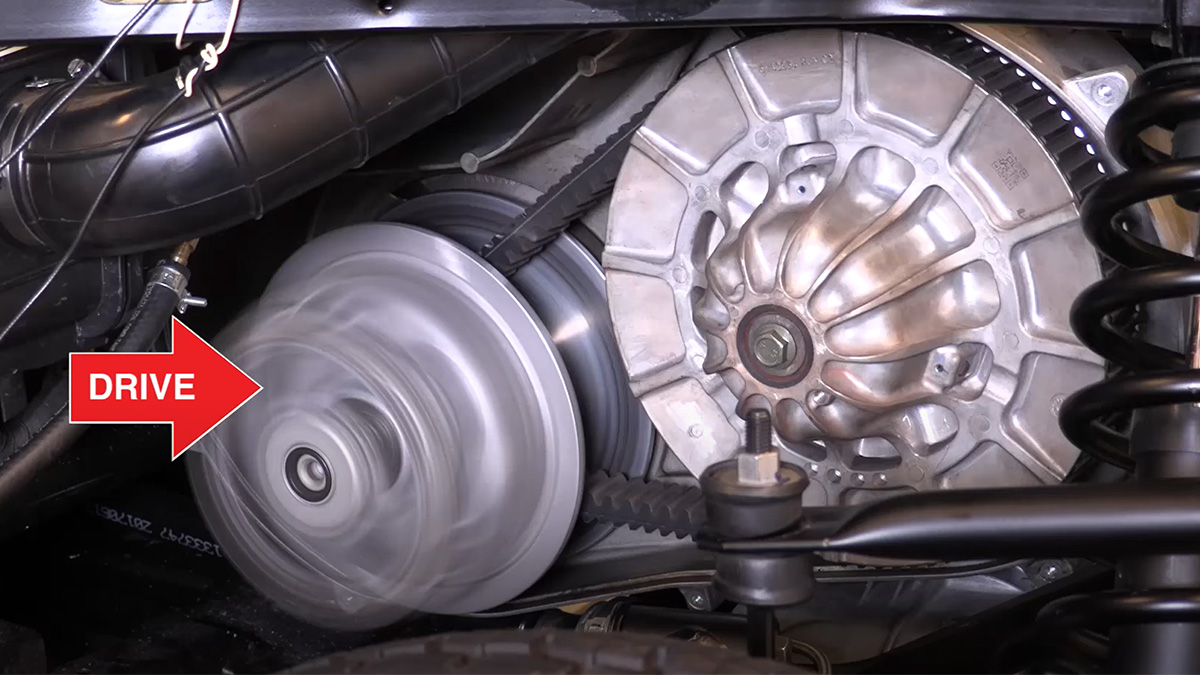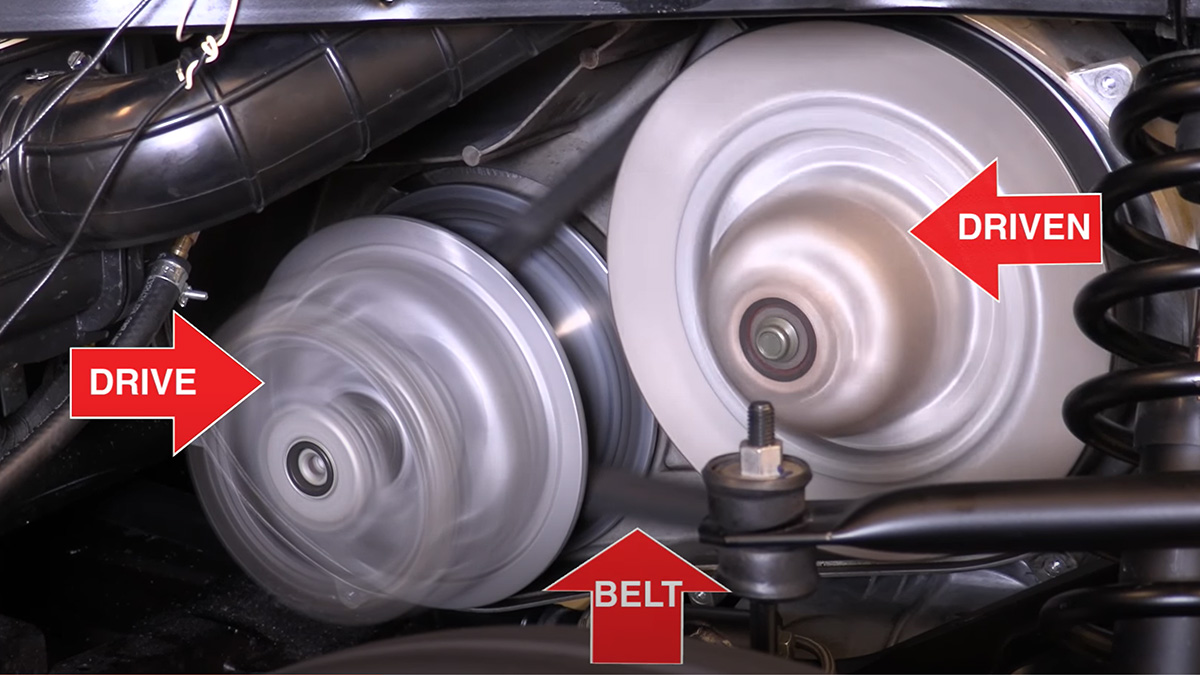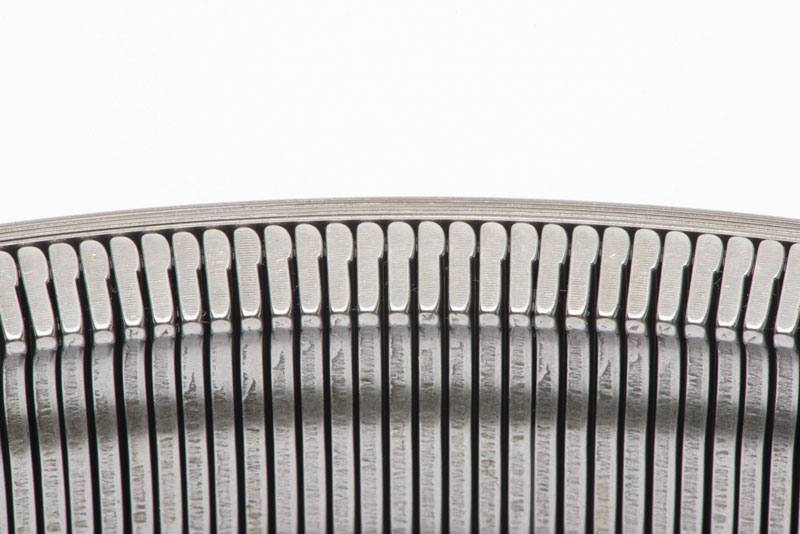“CVT” is an acronym for Continuously Variable Transmission. A CVT uses a pair of variable-diameter pulleys and a belt or chain to provide unlimited gear ratios. CVTs are gaining popularity due to their efficiency but they require dedicated CVT fluid to maximize their performance and life.
How does a CVT work?
First, consider a traditional automatic or manual transmission, typically built with three to six fixed gears (plus reverse). These transmissions operate in one gear at a time and a slight surge from the difference in power transmitted can often be felt with each gear change.
In contrast, CVTs offer unlimited gear ratios via a belt or chain connecting two pulleys that control power transmission from the engine to the wheels. The belt is designed with a series of V-shaped grooves that match the shape of the pulleys and changes the effective gear ratio by moving closer together or farther apart. As the pulley diameters change, the belt moves along the groove, allowing the transfer of rotational force from the input pulley to the output pulley.
A CVT allows the engine to always operate at its most efficient speed. A hydraulic pressure or electronic control system uses input from throttle position, engine speed, vehicle speed and other sensors to control the movement of the pulleys and determine the optimal gear ratio for the current driving conditions. The gear ratio is lower when the pulleys are closer, for better power and acceleration. The gear ratio is higher when the pulleys are farther apart, for better fuel economy at higher speeds.
The first CVT was developed for sawmills in 1879, and there have been several variations of CVT design. While the fundamental principles are the same, the mechanisms and components may differ, with more advanced modern systems using a computer to read the sensors and adjust pulley sizes.


CVT pros and cons
CVTs are becoming more common primarily due to increasingly restrictive environmental regulations that benefit from a CVT’s advantages over traditional automatic transmissions, including:
- Improved fuel economy
- Smoother acceleration
- Lower emissions
However, CVTs also have some disadvantages, including:
- More expensive
- Lower reliability
- Noisier
- Less driver feedback
Overall, CVTs are a viable choice for fuel economy and smooth acceleration. However, it can also make the car less reliable and less fun to drive, including a “rubber-band effect” when you rev the engine, but it takes a moment for power to catch up. Additionally, most CVTs can’t handle the power and torque of a truck or SUV, especially when used to tow your boat or camper, which is why you find them mostly on smaller cars, and powersports vehicles like snowmobiles and UTVs.

Maximizing CVT life
The transmission fluid ensures the belt or chain remains in contact with the pulleys, which is why CVTs require specialized fluids rather than traditional automatic or manual transmission fluid. CVT fluids are formulated with the correct frictional requirements to guard against belt slipping. Using the wrong fluid will reduce performance and potentially wreck your transmission.
Wear protection is also vital to maximizing CVT performance and life. We designed AMSOIL Synthetic CVT Fluid to fight wear and help extend transmission life and field tested it against a prominent vehicle manufacturer’s CVT fluid for 100,000 miles. The steel CVT belt lubricated with AMSOIL Synthetic CVT Fluid demonstrated minimal wear, as you can see in the image above.
CVT failures can be expensive, so make sure to protect your CVT with premium AMSOIL Synthetic CVT Fluid. Learn more in the video below.






I had the cvt transmission in a 05 honda civic hybrid and i loved that transmission setup it was perfect combo with the hybrid although wasnt a performance car or the 6 speed si i love so much, it did get great gas milage and was very smooth to drive. If you want smooth driving and great fuel economy than thats a great trans.
Are amsoil cvt oil suit to replace nissan ns-1 cvt oil?
Yes, AMSOIL Synthetic CVT Fluid is recommended for belt- and chain-type continuously variable transmissions requiring Nissan NS-1, NS-2 or NS-3.
Thanks.
I really glad to read this blog, your work is really amazing and the information will definitely useful for me personally, I have many bad experiences with this SVT transmission and now I feel by this blog I can overcome the problems. Is Nissan NS-1 requires for the transmission?
Hi Charles,
I’m not sure the language Nissan uses in its owner’s manuals, but it’s likely they “recommend” a Nissan-branded CVT fluid. Original equipment manufacturers, however, are prevented by law (Google the “Magnuson-Moss Warranty Act”) from requiring you to use their brand of fluid unless they provide it free of charge. AMSOIL Synthetic CVT Fluid is recommended for applications that call for Nissan NS-1, so rest assured you can safely use it and it’ll work great in your vehicle.
Thanks for reading.
They are putting CVTs in high horsepower farm tractors with 1800 ft/lbs of torque
Would’ve been nice to see a short cut away video of a cvt “in action”. Although my ’15 Civic has a cvt which works well, what I REALLY don’t like is the 5-10 second delay shifting when its cold/first drive of the day.
Own a 2017 highlander
What cvt oil and when to change
Is their a filter?
Hi James,
You can find all AMSOIL product recommendations for your vehicle using our Product Guide.
Thanks,
John
Please test the appropriate Amsoil product in a Subaru CVT.
I recently purchased a 2018 Nissan Murano. FYI: It has a CVT but Muranos are not on your vehicle list. According to the Owner Manual, NS-3 is the “recommended” fluid. The capacity is unstated. BTW, I really enjoy driving with this transmission.
Hi Grover,
The list isn’t exhaustive; it’s meant to show some of the most popular vehicles with CVTs.
Thanks,
John
Every CVT will take different amounts of fluid. This being said by the Nissan tech.
If you use the AMSoil Fluid in your CVT transmission do you still need to get the fluid changed every 30,000 miles as required by Nissan? If you don’t need to change the AMSoil fluid evey 30,000 like you do using the Nissan fluid would your warranty still be good with Nissan?
Hi Sam,
AMSOIL Synthetic CVT Fluid should be changed according to your vehicle manufacturer’s recommendations. So, in this case, you do need to change it every 30,000 miles. Also, using AMSOIL Synthetic CVT Fluid won’t affect your new-vehicle warranty.
Thanks,
John
Yes you have to change it and yes this does void the warranty I know from experience.
Hi Matt,
I suggest you go back and talk to the dealership. Following the OEM guidelines should not void the warranty. Nor does using a non-OEM brand of CVT fluid. Go here for more details.
Thanks,
John
Will there be any testing of amsoil ns3 vs amsoil cvt fluid?
Hi Gabriel,
AMSOIL Synthetic CVT Fluid is recommended for applications that call for the Nissan NS-3 specification. However, we have no plans right now to perform head-to-head testing against Nissan’s brand of CVT fluid.
Thanks,
John
Hi! I want to use the Amsoil transmission fluid in my Subaru Forester and I read that the old fluid needs to be completely drained. I am afraid that the person doing this is not going to totally drain the old transmission fluid out before adding the Amsoil CVTQT-EA transmission fluid. What percent of the old fluid needs to be drained before adding the Amsoil?
Thanks!
Hi Karleen,
Automotive CVTs have torque converters, so the same adage as a traditional automatic transmission applies (perform three pan drops or a single flush). While there is no specific percentage of old fluid that needs to be removed, every effort should be made to get as much of the old fluid out of the transmission before installing the new fluid. This will maximize the performance and extend the life of the new fluid. However, AMSOIL CVT fluid is compatible with other CVT fluids, so there are no issues mixing with the small amount of residual oil.
Thanks,
John
I have a Nissan Murano Automatic 2006 2.5L model. It is presently producing a squeeking sound mostly when i reverse. What could be the cause. I am told most Nissan Muranos have this problem. How can i solve this?
I would also like to find out what would happen to my car if i used a different oil from the recommendded Nissan Matic Oil.
Hi Mark,
Unfortunately, we can’t diagnose mechanical problems; I suggest visiting the dealership or a trusted mechanic. It could be due to the fluid losing its frictional properties, but that’s just a guess. Have your mechanic look at it.
Good luck,
John
How does this compare to Subaru High Torque CVT fluid used in 2017 Forester XT (turbo charged)?
Is AMSOIL CVT fluid compatible with SOA748V0200, and how does it compare?
Hi David,
Yes, AMSOIL Synthetic CVT Fluid is compatible with Subaru High Torque CVT Fluid (SOA748V0200). While we don’t have head-to-head testing for the product, AMSOIL CVT Fluid is designed to meet or exceed the OEM performance requirements, meaning it’ll provide excellent protection in your Subaru.
Thanks,
John
Hi , can I use this AMSOIL Synthetic CVT Fluid in my 2014 Subaru xv (auto). I think the model is TR580. TQVM.
Hi Edwin,
Yes, we recommend Synthetic CVT Fluid in your vehicle. Check out our Product Guide here.
Thanks,
John
Well I personally do not like the CVT transmissions I just had to replace mine and cost me over $2,500 they are junk transmissions and they should not be loud in vehicles
Hi
What is recommended AMSOIL ATF for TR580SHACA?
Thank you in advance.
Hi Zheko,
The best way to find the correct AMSOIL products for your vehicle is to use our Product Guide.
Thanks,
John